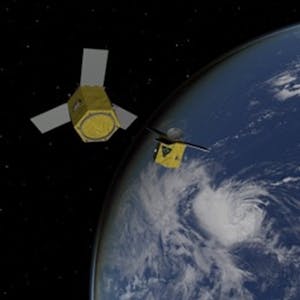This specialization delves into the complexities of spacecraft relative orbits, essential for various mission scenarios in space exploration and technology. It assumes learners have prior knowledge of orbital mechanics and focuses on the derivation of relative equations of motion about different reference orbits.
The course explores both nonlinear and linearized relative orbit descriptions, including curvilinear Cartesian coordinates and orbit element differences. Learners will understand the impact of perturbations on relative orbit geometry and develop feedback control laws to stabilize desired relative orbits. The course culminates in a capstone project where students develop long-range approach trajectories for a rendezvous maneuver and implement non-Keplerian relative motion reference trajectories for specific applications.
Certificate Available ✔
Get Started / More Info
The course modules cover spacecraft relative motion kinematics and kinetics, relative motion control, and a capstone project focusing on spacecraft formation flying and control, providing comprehensive knowledge essential for space mission scenarios.
Module 1 delves into spacecraft relative motion kinematics and kinetics, emphasizing the description of relative motion using various coordinates and the impact of perturbations on relative motion. Learners will also learn to set up bounded relative orbits for different chief eccentricities, providing a strong foundation for the subsequent modules.
Module 2 focuses on spacecraft relative motion control, where learners will numerically simulate spacecraft relative motion, analyze relative motion stability, and develop feedback control solutions for the stabilization of desired relative orbits. This module provides essential practical knowledge for spacecraft mission scenarios.
Module 3, the capstone project, allows learners to apply their knowledge in a simulated real-world scenario. Students will develop long-range approach trajectories for a rendezvous maneuver, implement non-Keplerian relative motion reference trajectories, and simulate relative motion control solutions in a body-fixed manner relative to the debris object. This practical application solidifies their understanding and prepares them for real-spacecraft missions.
This specialization offers a comprehensive foundation in electromagnetism and circuits, preparing learners for introductory physics courses and more advanced studies....
Astrobiology and the Search for Extraterrestrial Life explores the origin and evolution of life and the quest for life beyond Earth.
Kinematics: Describing the Motions of Spacecraft is a comprehensive course covering particle and rigid body kinematics, as well as static attitude determination,...
Strategies for winning. Meteorology in a round the world regatta provides essential knowledge of ocean meteorology and predictive modeling for sailors participating...